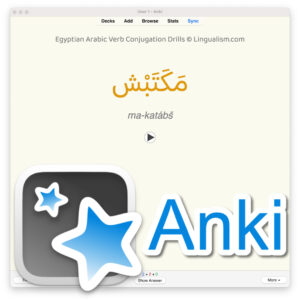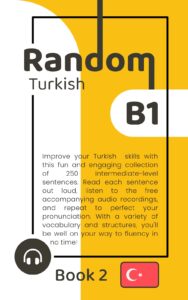Table of Contents
Introduction
Egyptian Arabic has no official spelling rules–no standardized orthography. Still, Egyptians do write in the colloquial language, perhaps increasingly in recent years with the advent of the internet and text messaging. So, how can we write in the Egyptian Arabic dialect if there’s no right or wrong–no rules to follow?
Well, the Egyptians seem to make it work. Most Egyptian Arabic words have cognates in MSA, so these spellings are applied to Egyptian Arabic whenever possible. For example, there’s no debate on how to spell the word for ‘book’. It’s كِتاب, just like in MSA. But when it comes to Egyptian Arabic words that are unique or significantly differ from MSA, there is less uniformity. Even then, there are usually only a couple of competing spellings. Individuals have their own preferences or use both interchangeably. كِده or كِدا (like that). هُمَّ or هُمّا (they).
The Lingualism Orthographic System
In Lingualism materials, we do our best to keep spelling consistent and in line with whichever spelling variant seems to be the most widely used. Our orthographic policies have evolved over time, so that you may see exceptions in older materials, but these will eventually be updated to match the current system.
Arabic script doesn’t always represent the exact pronunciation of Egyptian Arabic. When words take prefixes and suffixes, certain sound changes occur. Vowels are lengthened, shortened, or elided according to certain rules. The quality of vowels changes depending on adjacent consonants. Consonants can also become voiced or devoiced in certain positions. None of this is explicitly reflected in the Arabic script, but with the help of diacritics and knowledge of the rules of Egyptian Arabic phonology, you can determine nearly any given word’s pronunciation from the Arabic script.
For example, gāb جاب (‘he brought’) contains a long vowel, which is shortened when it is made negative: ma-gábš مجابْش (‘he didn’t bring’). This happens when a syllable ends in two consonants (here: _bš). But even though the vowel has been shortened, Egyptians still write the word with alif (ا).
Notable Consonants
Most consonants in Egyptian Arabic are pronounced as they are in Modern Standard Arabic (MSA)*. But how do Egyptians spell words that have markedly different pronunciation from MSA? Basically, if a word has a cognate in MSA, the spelling will mirror that word.
However, there are a couple of exceptions and notable cases. Let’s take a look:
ث
Egyptian Arabic does not have the ŧ ([θ] as in English thin) sound of MSA. This sound usually becomes s in Egyptian Arabic cognates, and sometimes t. When pronounced s, the original spelling with ث is kept. (It is not spelled with س.) But when it is pronounced t, it is written ت.
sánya ثانْيَة (second)–from MSA ثانية
tāni تاني another–from MSA ثانٍ
ذ
The same applies to ذ, which is pronounced đ ([ð] as in English that) in MSA but z or d in Egyptian Arabic. The spelling is retained when it is pronounced z. (It is not written as ز.) But it is written د when pronounced d.
záki ذكي clever–from MSA ذكي
xad خد he took–from MSA أخذ
ق
In Egyptian Arabic, qaaf (ق) is pronounced as a glottal stop, as if it were hamza (ʔ ء), in the majority of words, but it is still written as ق. In some everyday words (as well as in more formal words borrowed from MSA), ق is pronounced q. Since the spelling won’t help you determine whether the pronunciation is q or ʔ, you should refer to phonemic transcription or audio when in doubt.
ج
This letter has a distinctive pronunciation in Egyptian Arabic: g ([g] as in English gas), instead of MSA’s j ([dʒ] as in English jam).
gamīl جميل beautiful (vs. MSA jamīl جميل )
* Some consonant sounds vary somewhat in quality from MSA, but these subtle differences are handled in Egyptian Arabic Pronunciation.
Foreign Letters
Some additional letters are optionally used to represent foreign sounds in words borrowed from other languages. These letters have three dots instead of one. Most people don’t bother with them, so you’ll just need to know when, for example, a ب is actually pronounced p. One of the most common uses of these foreign letters seen on the streets in Egypt is garāž جراچ (garage). Of course, you can also see it spelled جراج. Companies often use foreign letters in their brand names to encourage a pronunciation truer to the original.
ڤ (or ف) v ڤودافون Vodafone
پ (or ب) p سڤن أپ Seven-Up
چ (or ج) ž ([ʒ] as in English vision) إل چي LG
Dots or No Dots?
Egyptians are known to have a habit of omitting dots on final ـي and ـة, writing ـى and ـه instead. You may even notice that some Egyptians seem to use the ي and ى keys (and ة and ه keys) interchangeably so that you’ll see ي with dots when it really should be ى and is pronounced -a. For example, you might see على (‘on’) written علي and عليه (‘on it’) may be written علية. But these inconsistencies reflect people’s difficulties finding the right key on the keyboard rather than an intentional style.
We had been mimicking the habit of omitting dots in most Egyptian Arabic Lingualism materials in the past, but as of 2020, we have changed our policy, by popular demand, to write go back to writing dots. Going forward, we will use dotted ـي and ـة, and past materials will eventually be updated as new editions.
When taa marbuuta is pronounced t as the first part of an idaafa construction, a sukuun is added: ـةْ:
3arabíyyit irrāgil عربيةْ الرّاجِل the man’s car
Hamza
Another habit of Egyptians is to omit the seated hamzas (above or below alif). In Lingualism materials, they were previously not written on alif at the beginning of a word, but going forward we will be writing hamza.
ána أنا I (previously انا)
ínta إنْتَ you (previously اِنْتَ)
آ is normally written even at the beginning of a word in Lingualism materials (but not consistently by Egyptians):
āxir آخِر final
qurʔān قُرْآن Quran
Separate or attached?
It is worth noting that, in Lingualism materials, the following prepositions and conjunctions are written separately (that is, with a space) from the word following them:
wi و and
fa/fā فا so (In older Lingualism materials, it is sometimes written attached as فـ.)
mi مِ from (optional short form of مِن before definite article)
3a عَ on (short version of the word علَى)
The following prepositions and particles are attached (that is, written without a space) to the following word:
ma- مـ not: ma-katábš مكتبْش he didn’t write
ha- هـ will. It is sometimes written حـ by Egyptians, but most people now use هـ, as this is how it is more commonly pronounced these days in Cairo. (In Alexandria, this prefix is still commonly pronounced ح.)
bi- بِـ in, at, with
It is common to see و written by Egyptians either separate or attached depending on individual preferences. Likewise, some مـ and هـ may be written separate as ما and ها (or حا), respectively.
Other spelling conventions
Shadda
Shadda is used instead of writing double consonants, following the rule in MSA. Most Egyptians also do this, so:
ba3átt بعتّ I sent (and not بعتْت).
ʔúlli قولّى (not قولْلى) tell me
Exception: ílli اللى (that, which, who) is written with two lam (ل), as the first two letters were originally the definite article.
Hollow verbs
Follow MSA rules for shortening the vowel of certain past tense forms:
ruɧt رُحْت I went (although many Egyptians tend to write a waw: روحْت.)
Diacritics
Tanwiin
Tanwiin sits on a final alif (In MSA, it should precede the following consonant, although some people disagree. In Egypt, the majority of people write it on the final alif, and so we’ve mimicked this habit in Lingualism materials.): aɧyānan أحْياناً sometimes
Default omissions
Fatha: By far the most common vowel in Egyptian Arabic is the short vowel a, which is represented in Arabic script by fatha ( ـَ ). In Lingualism materials, the fatha is normally omitted. So, if you see a consonant without tashkeel, you can assume it is an unwritten fatha. This is done to avoid redundancy and making the text look cluttered. Fatha is, however, written adjacent to waw (و) and yaa (ي) when they are pronounced as consonants (w and y, respectively) in order to distinguish them from long vowels:
wálad وَلد boy
yá3ni يَعْنى that is…
ɧawāli حَوالى about, around
ɧayāti حَياتى my life
In the rare cases where a word-final short a is not represented by ا or ـى, the fatha is written:
3a عَ on
má3a معَ with
húwwa هُوَّ he
Sukuun: Egyptian Arabic does not have i3raab (grammatical declensions). Compare ECA kitāb كِتاب (book) with MSA kitābun كِتابٌ. This implies that the final consonant would be written with a sukuun (كِتابْ), but, again, this is omitted to avoid redundancy. You can assume that a final consonant has an unwritten sukuun.
Long vowels are not preceded by harakat (short vowel marks):
nām نام he slept–not نَام
mīn مين who–not مِين
rūɧ روح go–not رُوح
The definite article الـ is written without tashkeel (instead of اِلْـ). This is done to avoid clutter: ilbēt البيْت the house (not اِلْبيْت); iššáms الشّمْس the sun (not اِلشّمْس).
This also applies to ílli اللى that, which, who.
(See Egyptian Arabic Pronunciation for details on the pronunciation rules for the definite article.)
Glides
ي and و can represent various sounds. As the long vowels ī and ū, they are not preceded by harakat. (See above.)
They can also represent two long vowel sounds not present in MSA: ē and ō. These are written with sukuun to distinguish them from the cardinal long vowels:
dēn ديْن debt (vs. dīn دين religion)
fōʔ فوْق above (vs. fūʔ فوق surpass)
As true diphthongs, fatha is written (ـَوْ and ـَيْ) to distinguish them from the above cases:
yáwmi يَوْمى daily (vs. yōmi يوْمي my day)
haykūn هَيْكون he will be
In summary:
wa وَ
ya يَـ
aw ـَوْ
ay ـَيْ
ō ـوْ
ē ـيْ
ī ـي
ū ـو
Shadda
Shadda is written as in MSA, even at the end of a word where we don’t actually hear the consonant pronounced twice. Why? It is perceived to be a double consonant and the shadda helps in word recognition. If, for example, a suffix is added, you would hear the consonant pronounced twice. Also, two consonants at the end of a syllable affect word stress.
baɧíbb بحِبّ (I love). Without the double consonant, the stress would incorrectly fall on the first syllable (báɧib بحِب). Although you can’t hear the consonant pronounced twice when the word is in isolation, you can when it precedes another word in context:
baɧíbbə mámti بحِبّ مامْتي I love my mom.








Great summary on Egyptian pronunciation. I absolutely love that you use Arabic alphabet along with Latin transcript. The book Colloquial Arabic by TF Mitchell (1982) doesn’t even teach the Arabic letters, totally confusing., and easily the most useless language book I have.